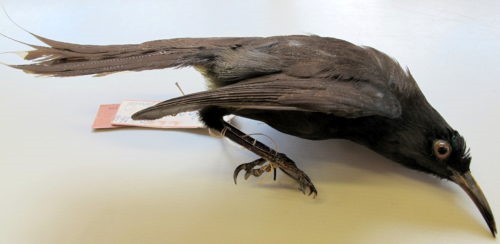Birdfinding.info ⇒ The Oahu O’o is known only from ten specimens, the last three of which were collected in Nu’uanu Valley between January 11 and 15, 1837. Like other Hawaiian honeyeaters, it was rare in part due to persecution for its feathers. By the time of its formal scientific description in 1860 it was likely extinct.
Oahu O’o †
Moho apicalis
Extinct. Formerly endemic to Oahu.
Identification
A large, cuckoo-like honeyeater that was black overall with yellow sides, flanks, and vent, white wing linings, and white tips on the tail feathers that were visible on the underside—or as white outer edges on the uppertail.
The sexes were similar except that females were somewhat duller and shorter-tailed.

Oahu O’o, ventral view. (Natural History Museum at Tring.) © Andrew Esposito

Oahu O’o, side view. (Natural History Museum at Tring.) © Andrew Esposito

Oahu O’o, ventral view. (Natural History Museum at Tring.) © Andrew Esposito

Oahu O’o, male and female. John Gerrard Keulemans, 1900
Notes
Monotypic species.
IUCN Red List Status: Extinct.
References
BirdLife International. 2017. Moho apicalis (amended version of 2016 assessment). The IUCN Red List of Threatened Species 2017: e.T22704329A111776064. https://dx.doi.org/10.2305/IUCN.UK.2017-1.RLTS.T22704329A111776064.en. (Accessed June 10, 2020.)
Hume, J.P. 2017. Extinct Birds (Second Edition). Bloomsbury Publishing PLC, London.
Pyle, R.L., and P. Pyle. 2017. The Birds of the Hawaiian Islands: Occurrence, History, Distribution, and Status. Version 2 (January 1, 2017). http://hbs.bishopmuseum.org/birds/rlp-monograph/. B.P. Bishop Museum, Honolulu, Hawaii.
